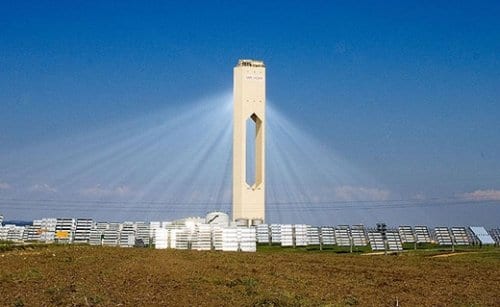Spain’s concentrated solar power association, Protermosolar has published a report that models a plan to achieve 85 per cent renewable energy by 2030 using a combination of wind, solar PV, and concentrated solar power (CSP) technologies.
The association believes would also reduce emissions by 92% by cutting coal and nuclear out of the electricity system altogether.
The report was developed in response to a similar report published by a “Committee of Experts” commissioned by the former conservative Spanish Government designed to inform the country’s Energy Transition and Climate Change Law, which minimised the role of renewable energy in favour of keeping coal and nuclear and scaling up combined-cycle gas generation.
The Protermosolar report – which was based not so much on computer models but on projections made from actual generation and demand data – posits a total of 106 GW worth of renewable energy, including 33 GW worth of wind, 25 GW of solar PV, 20 GW of CSP, and 5 GW of other renewable energies.
Another 23 GW worth of hydro and pumped-hydro, 15.8 GW worth of combined-cycle gas, and 8.5 GW of co-generation would fill out the total electricity mix.
Comparing the two reports, Protermosolar’s plan would see a 60% reduction of carbon emissions compared to the Committee of Experts plan (in other words, 60% reduction in emissions on top ofthe reductions proposed by the Committee of Experts), bringing the total carbon emissions reduction to 92%.
More specifically, carbon dioxide emissions would only reach 4,991 kt compared to the 12,593 kt projected by the Committee of Experts.
Additionally, the Committee of Experts plan would not actually meet the recently-approved European Union target of a 32% renewable energy contribution to total energy consumption.
However, the Protermosolar plan would not only meet the EU target but would also reduce the amount of annual curtailed renewable energy – from 4.6 terawatt-hours annually in the Committee of Experts plan to only 830 gigawatt-hours annually.
The trick was to decrease the amount of solar PV used in the Committee of Experts plan from around 47 GW down to a cap of 25, while scaling up CSP from its current level of 2.3 GW to 20 GW.
All of this would be combined with around 15 hours’ worth of thermal storage, which would store energy during the day and be fed back into the country’s electricity grid at night.
The plan also includes the expectation of “reasonable” improvements to the renewable energy technologies, resulting in a range of average costs – €20/MWh for hydro, €40/MWh for wind, €35/MWh for solar PV, and €55/MWh for CSP.
GTM Research, who spoke to Protermosolar’s president, Dr. Luis Crespo Rodríguez, highlighted the unusually low expected cost for CSP, comparing it to Lazard’s most recent levelized-cost range of between $90 and $181/MWh (or between €77 to €155/MWh).
However, Rodríguez told GTM that he thought it was a reasonable expectation, and pointed to a recent project being developed by ACWA Power which was given a tariff of $73/MWh last September (or around €62/MWh), adding that “We think that with a 17-gigawatt market in Spain, having a price of €55 is not excessive.”
Protermosolar’s study shows that scaling up CSP capacity would not only help reduce emissions and provide the necessary electricity, it would also make a significant contribution to the Spanish economy – to the tune of €62,000 million, or €3.5 million per MW across 17.7 GW.
Construction of so much CSP would also create 88,500 jobs per year, and an additional 1,770 jobs per year for operations.
Author’s note: Article source was a Spanish to English translation of the Protermosolar press release, found here.










